I started doing an End of Month View in August 2016 having seen Helen Johnstone’s blog, The Patient Gardener, on my reader. In August 2009 she invited bloggers to join her End of the Month View by adding a comment and link to their End of Month View.
This simple idea has certainly caught on with many bloggers contributing to a global End of Month View community each month. Recently demands on Helen’s time have meant she is reluctantly giving up her hosting of the End of Month View.
The idea is too good to let it disappear and I have offered to pick up the mantle of hosting the End of Month View. I am sure you will all join me in thanking Helen for hosting this over the last 8 years and wish her the very best for the future.
In the meantime please add your comments to my blog together with a link to your End of Month View. Also please add a link back to here at the end of your blog so that other readers can find their way to all the contributors to the End of Month View.
Thank you.
Glebe House Garden – End of the Month View – August 2017
The weather this August has very variable with lots of rain and grey overcast skies. Temperatures have ranged from very cool, cool enough to actually switch on the heating in our house, to record breaking temperatures at the end of the month. As always the best growing plants have been the weeds and the borders need to be patrolled frequently for specimen weeds which can suddenly appear!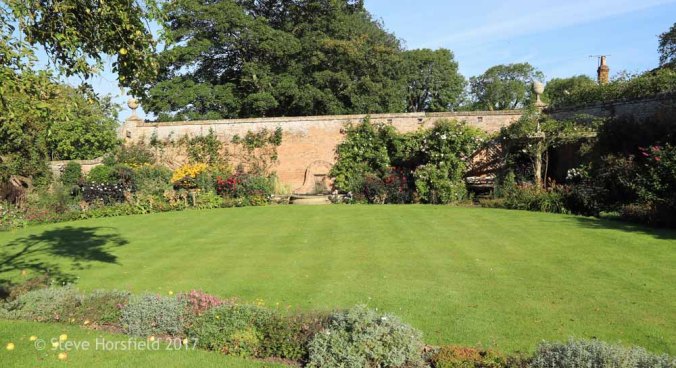 This is the view I often centre on in my EoMV, looking across our main lawn to the old kitchen garden wall.
This is the view I often centre on in my EoMV, looking across our main lawn to the old kitchen garden wall.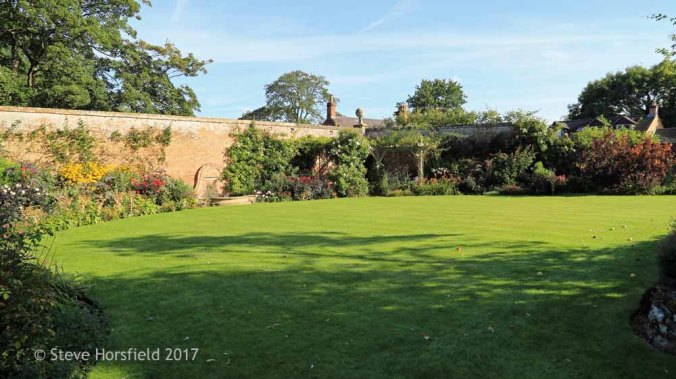 The same walls and border looking diagonally across the lawn.
The same walls and border looking diagonally across the lawn. 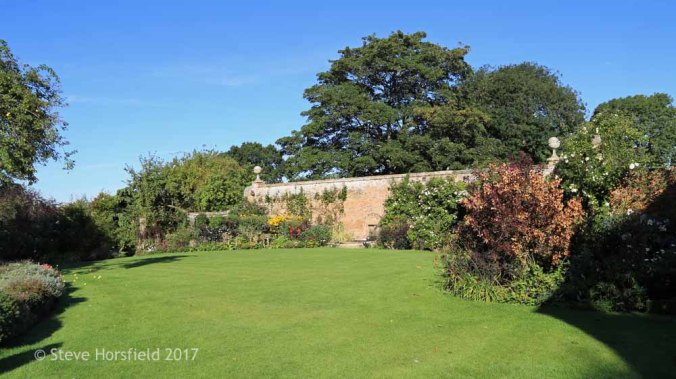 And looking along the other diagonal. Originally the kitchen garden wall extended across the lawn to form a kitchen garden enclosed on three sides and open on the fourth where there was probably a hedge.
And looking along the other diagonal. Originally the kitchen garden wall extended across the lawn to form a kitchen garden enclosed on three sides and open on the fourth where there was probably a hedge.  The late summer border is starting to look very full with many of the herbaceous plants growing very tall and needing plenty of staking to prevent them falling across other smaller plants.
The late summer border is starting to look very full with many of the herbaceous plants growing very tall and needing plenty of staking to prevent them falling across other smaller plants.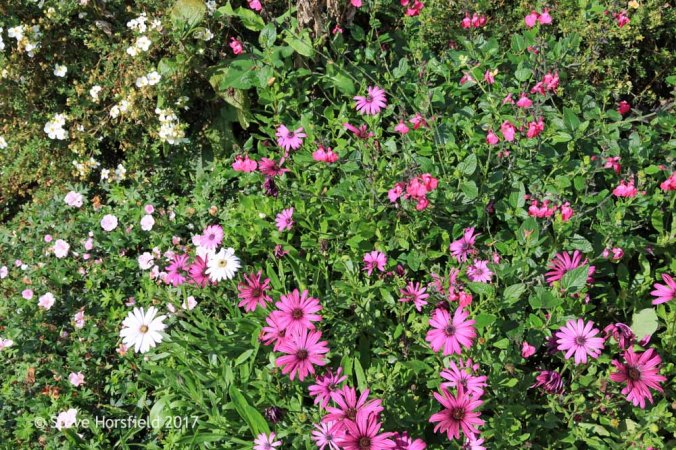 At the corner of this bed is one of those lucky combinations of colour with the soft pink of Geranium sanguineum striatum, the dark red of Osteospermum ‘Tresco Purple’ and the red of Salvia ‘Cerro Potosi’. The white/pink osteospermum is a very hardy osteospermum my mother gave me but as we do not know the variety and so we call it Nancy’s osteospermum after my mother!
At the corner of this bed is one of those lucky combinations of colour with the soft pink of Geranium sanguineum striatum, the dark red of Osteospermum ‘Tresco Purple’ and the red of Salvia ‘Cerro Potosi’. The white/pink osteospermum is a very hardy osteospermum my mother gave me but as we do not know the variety and so we call it Nancy’s osteospermum after my mother! The tall plant is Helianthus ‘Lemon Queen’. This was only planted in April this year and has certainly grown well. However, “the jury is still out” on whether it stays. Yes the flowers are there but many are covered with the green leaves. Maybe the flowers will be more prominent later in September. We will have to wait to see.
The tall plant is Helianthus ‘Lemon Queen’. This was only planted in April this year and has certainly grown well. However, “the jury is still out” on whether it stays. Yes the flowers are there but many are covered with the green leaves. Maybe the flowers will be more prominent later in September. We will have to wait to see.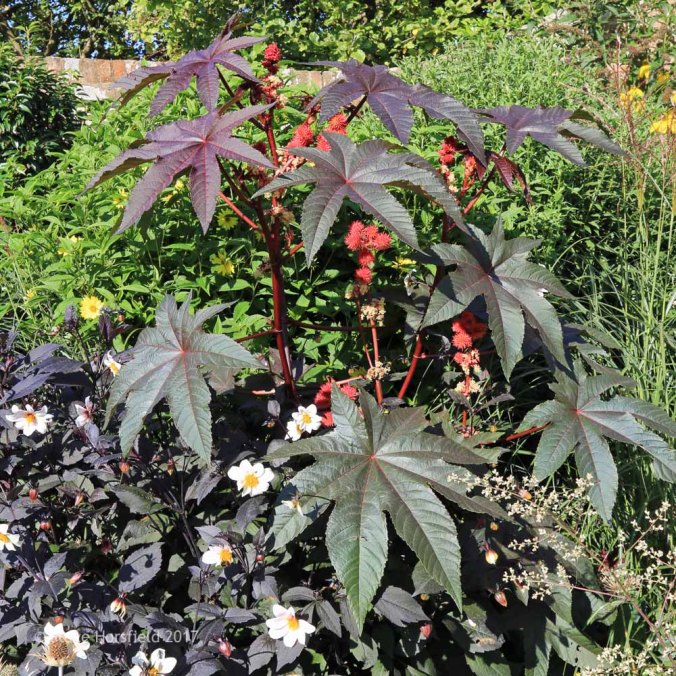 The star of the border continues to be Ricinus communis ‘Impala’
The star of the border continues to be Ricinus communis ‘Impala’  The leaves of which are absolutely fantastic. These are grown from seed and as such are only a few pence each.
The leaves of which are absolutely fantastic. These are grown from seed and as such are only a few pence each.
To the right of this corner before the pond are a couple of blue flowered plants. Clematis ‘Wyevale’ at the back and Salvia ‘Phyllis Fancy’ towards the front and in the detail picture (with a red salvia photo bombing!). Salvia ‘Phyllis Fancy’ has been relatively hardy although I do take cuttings each year.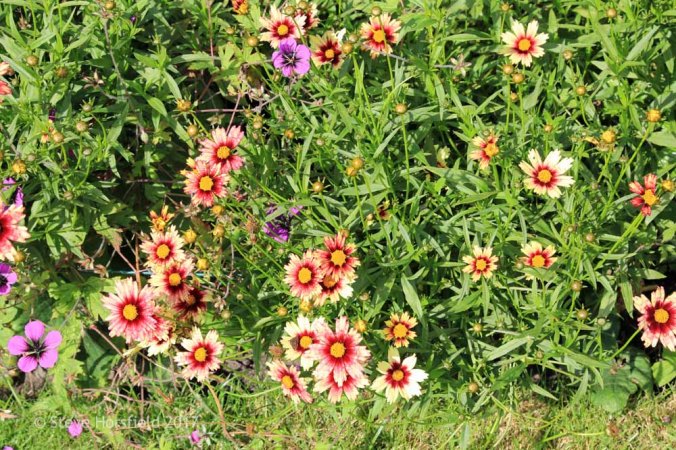 Coreopsis ‘Redshift’ a new plant this year at the front of the corner bed. Lots of flowers but seems to flop very easily.
Coreopsis ‘Redshift’ a new plant this year at the front of the corner bed. Lots of flowers but seems to flop very easily. I found this caterpillar making great speed across the lawn. It was about 3 inches long with two pairs of false eyes and a small horn on its tail. At first I was fooled and thought it was a snake! A bit of research identified it as probably an elephant hawk moth caterpillar.
I found this caterpillar making great speed across the lawn. It was about 3 inches long with two pairs of false eyes and a small horn on its tail. At first I was fooled and thought it was a snake! A bit of research identified it as probably an elephant hawk moth caterpillar. The other corner of the wall has a green oak pergola to provide a seating area and some shade. The rose growing up the pergola is Rosa ‘Blush Noisette’
The other corner of the wall has a green oak pergola to provide a seating area and some shade. The rose growing up the pergola is Rosa ‘Blush Noisette’

- Rosa ‘Blush Noisette’
The pergola has a number of grape vines that grow across the top to provide the shade. Grape vines grow at a rapid rate and in the summer some pruning of the new growth is require to achieve a dappled shade and also to encourage bunches of grapes to form.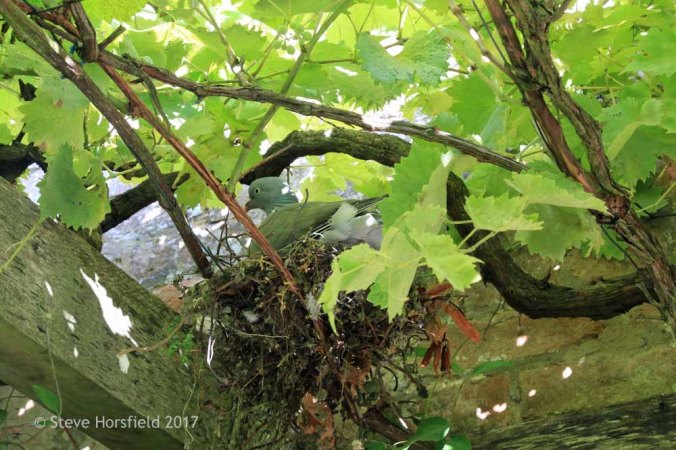 This year I could only prune half the vines back as a pigeon had decided to make a nest in the vine.
This year I could only prune half the vines back as a pigeon had decided to make a nest in the vine. 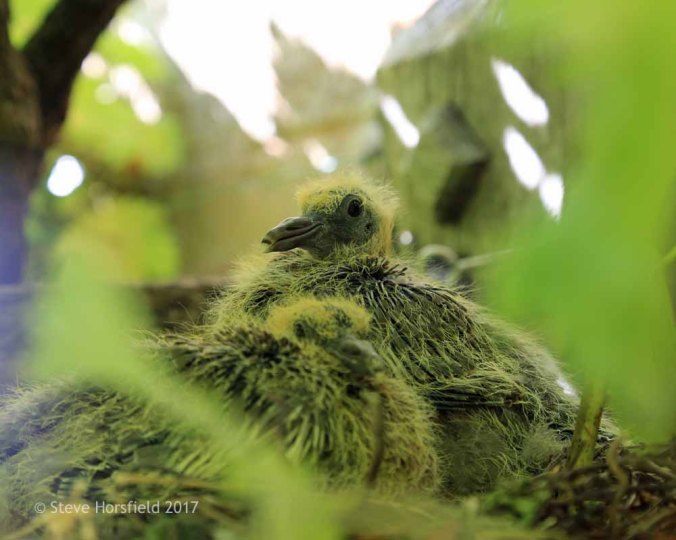 This week two chicks hatched out and are doing well but the vine remains un-pruned.
This week two chicks hatched out and are doing well but the vine remains un-pruned.
At this time of year the border to the left of the pergola contains mostly dahlias; Bishop of Llandaff and Bishop of Auckland. Although our dahlias started slowly the weather through August has given them all a real spurt of growth with Bishop of Llandaff up to five feet high.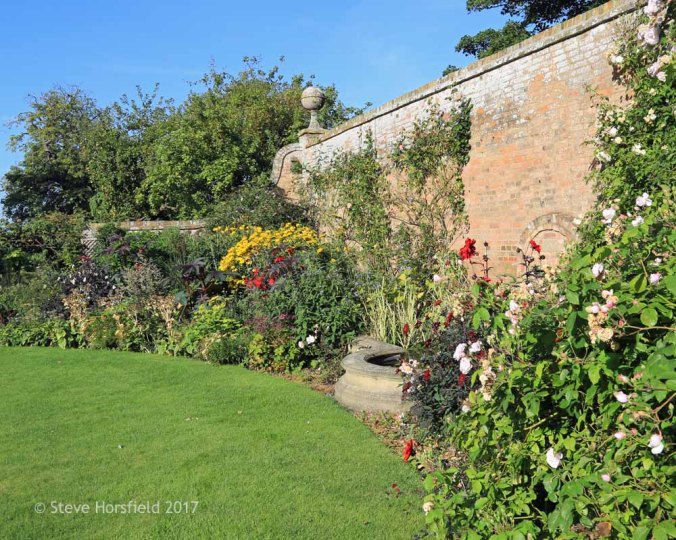 Looking back from the pergola to the corner bed.
Looking back from the pergola to the corner bed.
You can just see a rose on either side of the pond. These were planted this year and are Rosa Pink Gruss an Aachen, a small rose plant that seems to like the location.
To the right of the pergola the outstanding plant is Salvia involocruta bethellii. This has proved to be very hardy. We cut it down to the ground each year but it produces huge plants with many flowers.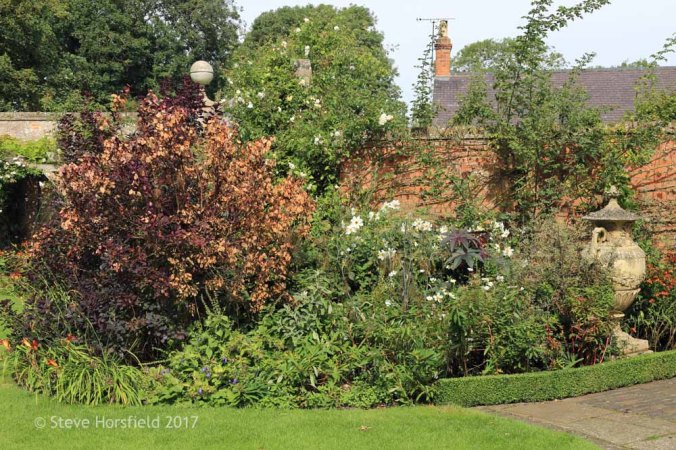 The end of the wall on the right has a very sad looking Cotinus ‘Nottcutts Variety’. Normally it has very attractive dark coloured foliage but this year it seems to be dying! The foliage has gone dry and brown and is spreading through the shrub. Looks like this will be coming out soon.
The end of the wall on the right has a very sad looking Cotinus ‘Nottcutts Variety’. Normally it has very attractive dark coloured foliage but this year it seems to be dying! The foliage has gone dry and brown and is spreading through the shrub. Looks like this will be coming out soon.
| 2017 Gardening Hours | ||
| Week beginning August 19th |
Total 2017 to-date | Average per week |
| 32 | 703 | 21 |
A busy week in the garden, cutting out some of the “autumn” in the border, a lot of hedging and of course weeding.
All are welcome to join in with the End of Month View community. You can use it how you like all I ask is that you add a link to your post in the comment box below and if possible it would be great if you could link to this post from your post.






 Rudbeckia ‘Herbstone’ grows to almost two metres at the back of the border but does need staking to stop it falling on other plants.
Rudbeckia ‘Herbstone’ grows to almost two metres at the back of the border but does need staking to stop it falling on other plants.










 This circular bed (stone edged bed on the
This circular bed (stone edged bed on the  Rudbeckia fulgida sullivantii ‘Goldsturm’ should always have a place in the August border.
Rudbeckia fulgida sullivantii ‘Goldsturm’ should always have a place in the August border. At first this looked like a new plant formed when a Perovskia ‘Blue Spire’ decided to climb up a Foeniculum vulgare ‘purpureum’.
At first this looked like a new plant formed when a Perovskia ‘Blue Spire’ decided to climb up a Foeniculum vulgare ‘purpureum’.  I always grow some Ricinus communis ‘Impala’ from seed each year starting them off in the greenhouse and planting out when the dahlias go in. The leaves are fantastic architectural additions to any border but note that they donot overwinter here.
I always grow some Ricinus communis ‘Impala’ from seed each year starting them off in the greenhouse and planting out when the dahlias go in. The leaves are fantastic architectural additions to any border but note that they donot overwinter here.  There are many different Dahlias in our garden This is one of my favorites, Dahlia ‘Bishop of Aukland’.
There are many different Dahlias in our garden This is one of my favorites, Dahlia ‘Bishop of Aukland’. This is Phlox paniculata Uspekh a plant I saw on a garden visit and just had to have for its strong colours.
This is Phlox paniculata Uspekh a plant I saw on a garden visit and just had to have for its strong colours. Colour combinations are important in the garden. Often it is the plants themselves which seem to combine in good ways. Here we have Achillea ‘Credo’ with Salvia greggii ‘Emperor’, as close to complementary colours as you can get.
Colour combinations are important in the garden. Often it is the plants themselves which seem to combine in good ways. Here we have Achillea ‘Credo’ with Salvia greggii ‘Emperor’, as close to complementary colours as you can get. Here Helenium ‘Moerheim Beauty’ is absolutely stunning but look closely a Cerastostigma willmottianum ‘Forest Blue’ has got into the picture. Complementary colours again!
Here Helenium ‘Moerheim Beauty’ is absolutely stunning but look closely a Cerastostigma willmottianum ‘Forest Blue’ has got into the picture. Complementary colours again!

 And other day lilies have also done well, here is Hemerocallis ‘Stafford’.
And other day lilies have also done well, here is Hemerocallis ‘Stafford’. A shrubby clematis, Clematis ‘Wyevale’, comes back every year and has a long flowering period.
A shrubby clematis, Clematis ‘Wyevale’, comes back every year and has a long flowering period. Cone flowers, Echinacea purpurea, are loved by insects and look fantastic in the garden.
Cone flowers, Echinacea purpurea, are loved by insects and look fantastic in the garden.

 Osteospermums have a long flowing period and look great. This is Osteospermum ‘Tresco Purple’ which is hardy in some places but so far not here so I take cuttings every year.
Osteospermums have a long flowing period and look great. This is Osteospermum ‘Tresco Purple’ which is hardy in some places but so far not here so I take cuttings every year. Sowed a bit late but this Rudbeckia came from a packet of seed described as Rustic Dwarfs Mixed and has produced some stars. I will try getting Rudbeckia plants from seed every year now.
Sowed a bit late but this Rudbeckia came from a packet of seed described as Rustic Dwarfs Mixed and has produced some stars. I will try getting Rudbeckia plants from seed every year now. Another plant from seed is Cosmos, this is Cosmos versailles tera and produces some very strongly coloured flowers.
Another plant from seed is Cosmos, this is Cosmos versailles tera and produces some very strongly coloured flowers. This is new to me, Maurandya ‘Magic Dragon’.
This is new to me, Maurandya ‘Magic Dragon’.  Another climber, Clematis ‘Jackmanii’, has been doing great things although this year has not produced the best from clematis which I suspect was due to lack of rain through the spring.
Another climber, Clematis ‘Jackmanii’, has been doing great things although this year has not produced the best from clematis which I suspect was due to lack of rain through the spring. Last but not least, Anemone ‘Honorine Joubert’, a great plant not least because it copes with shade well.
Last but not least, Anemone ‘Honorine Joubert’, a great plant not least because it copes with shade well.
 The new house, designed by John Tasker, was begun in 1811 with gardens and parks in the ‘romantic’ style of the time creating long vistas over the lake and sweeping lawns grazed by deer.
The new house, designed by John Tasker, was begun in 1811 with gardens and parks in the ‘romantic’ style of the time creating long vistas over the lake and sweeping lawns grazed by deer.
 The grounds were enlarged and improved for a third time from about 1897 by the celebrated gardener Ellen Willmott and her sister Rose. Robert Valentine Berkeley married Rose in 1891 and, together with her sister, she transformed the planting in the gardens with long borders densely packed with plants.
The grounds were enlarged and improved for a third time from about 1897 by the celebrated gardener Ellen Willmott and her sister Rose. Robert Valentine Berkeley married Rose in 1891 and, together with her sister, she transformed the planting in the gardens with long borders densely packed with plants.
 This is a cork oak, Quercus suber, the primary source of cork for wine bottle stoppers and other uses, such as cork flooring and as the cores of cricket balls and an unusual tree in England.
This is a cork oak, Quercus suber, the primary source of cork for wine bottle stoppers and other uses, such as cork flooring and as the cores of cricket balls and an unusual tree in England. The bridge over the canal from the garden pool with the new rose garden in the background.
The bridge over the canal from the garden pool with the new rose garden in the background.
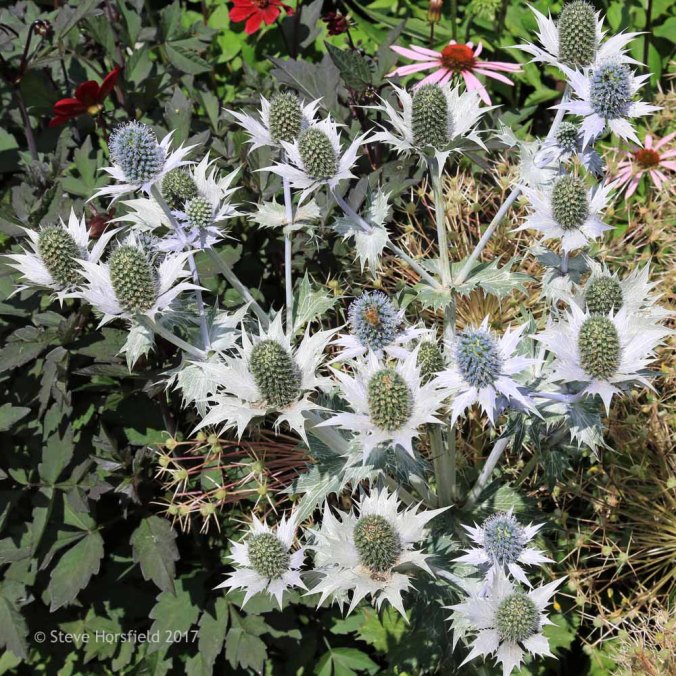


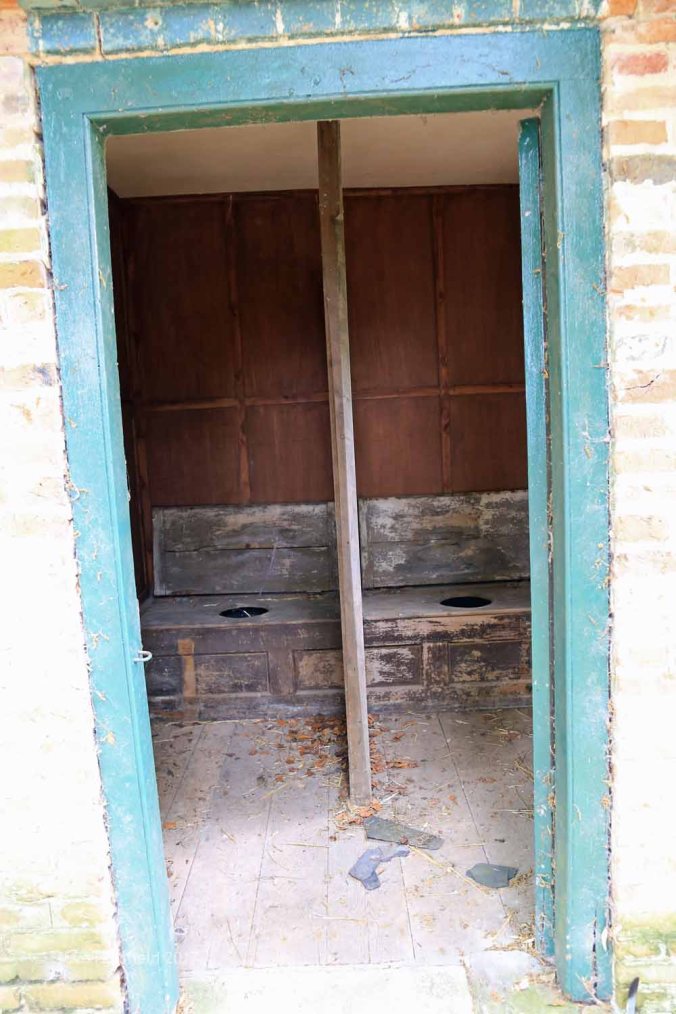 and at Spetchley there is a very fine example, with room for two, located in a old brick built building in the garden.
and at Spetchley there is a very fine example, with room for two, located in a old brick built building in the garden.



 A corner of the walled garden now devoted to flowers.
A corner of the walled garden now devoted to flowers.

 Some exotic planting in the melon yard.
Some exotic planting in the melon yard. No important house in England would be without a chapel and Spetchley is no exception with some very fine memorials to the Berkeley family in the nave.
No important house in England would be without a chapel and Spetchley is no exception with some very fine memorials to the Berkeley family in the nave.

